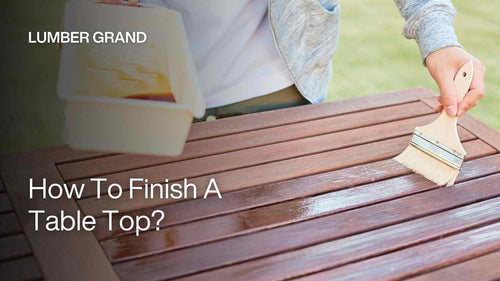Are you looking to create a unique piece of furniture that reflects your style? An epoxy coffee table DIY is a great way to combine your woodworking experience with your artistic skills. Follow this guide with an easy 7 steps process for building the ideal epoxy coffee table, including select slab options, resin pouring techniques, and tips for maintaining your epoxy table.
How to Make an Epoxy Coffee Table DIY?
Building an epoxy table through DIY methods is more simple than you thought. All you need to build an epoxy coffee table DIY is some basic tools, materials, and these detailed instructions that focus on both durability and visual appeal:
1. Step 1: What You’ll Need
Your first step should involve acquiring all necessary materials along with tools. Preparation takes essential precedence to minimize problems with both delays and mistakes throughout the project.
Materials:
- You will need wood slab or boards in either live edge or straight cut form from kiln-dried timber to make the table top.
- Epoxy resin combined with its hardening agent requires users to determine appropriate quantities through an epoxy calculator.
- Epoxy color pigments, dyes, or metallic powders (as an optional addition).
- Cutting molds require either a mold release tape or silicone material.
- The mold requires either clear plastic sheeting or HDPE boards.
Tools:
- Mixing buckets (graduated).
- You will need both stir sticks and a mechanical mixer that uses a low-speed drill attachment.
- A heat gun combined with a propane torch pops air bubbles when working.
- Level provides the needed device for flat surface alignment before pouring.
- Clamps (for holding wood pieces in place).
- Safety gear: gloves, respirator mask, goggles, apron.
- Orbital sander (60 to 400 grit sandpaper).
- Table legs and mounting hardware.
- Electric drill and screws.
- High-quality epoxy resin intended for deep pours between 1-2 inches is used when making rivers and thick design.
 High quality epoxy resin formulas often have the resin to hardener ratio of either 1:1 or 2:1
High quality epoxy resin formulas often have the resin to hardener ratio of either 1:1 or 2:1Photo: diycreators on Instructables.com
2. Step 2: Preparing the Surface for Epoxy
Dry wood with less than 12% moisture content is essential for preventing bubbles and warping during the process. Inspect for cracks and knots. Apply wood filler and add a minimum of epoxy to address bigger voids in the wood surface. Sand until smooth. Before application, seal every surface that will contact epoxy with a light epoxy layer to prevent air bubbles from forming.
Build a mold if needed. You should work with materials that consist of melamine and plywood, and HDPE boards. Surface refinement requires mold release tape application or a spritz of silicone or wax as mold removal solutions. Insert the wood within the mold properly, then flatten a level surface. The finish will become distorted when you tilt the surface because this produces an uneven epoxy flow.
 Sand the wood until smooth
Sand the wood until smooth
Photo: ©Daniel Reche, Maria Orlova on Canva.com
3. Step 3: Mixing the Epoxy Resin
Precision becomes the absolute requirement for this step. Different resin formulas need an exact resin-to-hardener mixture of either 1:1 or 2:1. You should adhere to the manufacturer-provided exact measurements when mixing the resin and hardener.
Use a low speed as you mix for 3-5 minutes while also scraping the entire inner surface. Mixture speed during stirring generates air bubbles, which contaminate the clarity output - a critical factor in epoxy coffee table DIY projects where transparency and finish matter.
Every success depends on obtaining precise ratios when mixing mica powders and metallic pigments and alcohol dyes to add depth and color. Running a small-size color test is essential before finishing the complete mix.
The mix needs 3-5 minutes of sitting time, and a vacuum chamber will help remove trapped air to achieve crystal-clear results.
 Resin mixing must be done slowly and thoroughly
Resin mixing must be done slowly and thoroughly
Photo: ©Thirdman on Canva.com
4. Step 4: Pouring the Epoxy onto the Coffee Table
The pouring process defines the appearance of your table, so don’t rush it.
-
Begin by performing a thin initial coat with brush application to protect the wood surface as well as bubble-trapping.
-
Layered pours need controlled amounts of 1/2 to 1 inch additives with sufficient curing intervals between installations to prevent cracks. This prevents overheating and cracking.
-
Apply heat from a gun or torch to the surface for about 10-15 minutes during the first hour while looking for air bubbles to disappear.
-
Check the mold seams regularly while placing barriers to detect leaking epoxy before it hardens.
-
Add stones and shells with leaves or LED lights to your epoxy layers by embedding objects for decorative purposes when following this design tip.
-
Increments of ½ to 1 inch, allowing curing time between layers as needed. This prevents overheating and cracking.
-
Using a heat gun or torch, pass it lightly over the surface every 10-15 minutes during the first hour to remove air bubbles.
-
Use barriers and check mold seams frequently to catch leaks before they harden.
-
Design Tip: You can embed objects like stones, shells, leaves, or even LED lights between epoxy layers for a custom effect and turn your unique epoxy table top ideas into real life!
 The heat gun is used to remove air bubbles
The heat gun is used to remove air bubbles
Photo: ©Thirdman on Canva.com
5. Step 5: Curing and Drying
Your epoxy coffee table's durability depends directly on the curing process.
-
The curing process needs 24-72 hours based on your epoxy product specifications and the surrounding temperature conditions. Movement of the piece must be prevented throughout this period.
-
Your table requires a curing temperature between 70-80 degrees Fahrenheit (21-27 degrees Celsius). The curing process takes longer at lower temperatures, however, high temperatures can lead to damage of the epoxy.
-
Protection against dust occurs through covering the table with clean plastic sheeting or a movable box.
-
The epoxy will reach its hardened state with a glassy consistency and smooth texture after its complete curing process is finished. It is possible to remove any surface flaws before proceeding to the next process.

The glassy finish your epoxy project should reach after being completely cured
Photo: diycreators on Instructables.com
6. Step 6: Finishing Touches and Assembling
Finish your epoxy coffee table DIY by bringing it to life through refined completion and final joining steps.
-
Begin by using 120 grit sandpaper followed by 400 grit (you can reach 1000+ to achieve a shiny, glass-like surface). The process of wet sanding allows you to eliminate delicate scratches from the surface.
-
To finish the surface, add either a buffing compound or polishing paste through rotary tool or buffer usage. The end surface treatment should use clear polyurethane or oil to achieve your desired sheen.
-
The attaching process requires you to drill pilot holes in marked locations before permanently securing the table base. Additional strength can be achieved through the use of brackets when needed.
 Adding a table base completes your epoxy masterpiece with elegance and function
Adding a table base completes your epoxy masterpiece with elegance and functionPhoto: Lumber Grand
Shop now: Round Epoxy Coffee Table 35 Inches; Round Epoxy Coffee Table 15 Inches
Tips for Maintaining Your Epoxy Coffee Table
Here are Lumber Grand's suggested care instructions that will help your table look new throughout many years:
-
A microfiber cloth paired with mild dish soap enables regular cleaning of your table. Avoid ammonia-based cleaners like Windex.
-
The material remains heat resistant, yet it does not provide complete heat resistance. Always use coasters and trivets.
-
Never pull things across the surface, as this creates scratches. The material exhibits durability, yet sharp objects will damage its surface.
-
Apply polish or wax new layers just a few times per year in order to preserve the shine and protect against microscopic surface damage.
-
The prolonged exposure to direct sunlight leads to yellow discoloration on surfaces. The table surface benefits from applying UV-resistant topcoats, but it should remain in areas with minimal sunlight exposure.
Our email address contact@lumbergrand.com is open for any questions or inquiries about additional epoxy products.
The combination of proper tools, technical expertise, and patience in epoxy table construction produces a quality epoxy coffee table DIY that matches those found in expensive retail stores. First-time creators as well as those expanding their custom collection can achieve complete design uniqueness through the use of epoxy. Ready to create your own? Start building today.

















































